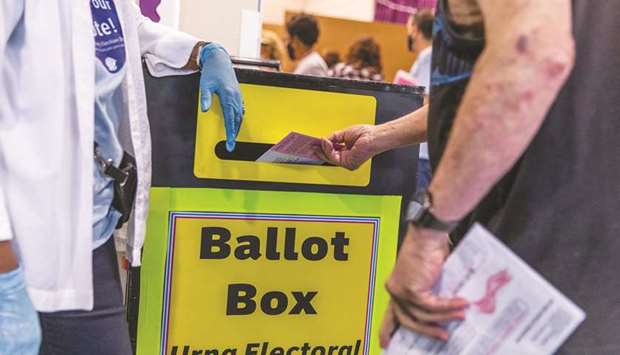Emerging markets head into the last full trading week before the US election with stocks and currencies near their highest levels since January and dollar-bond spreads close to their narrowest since February.
Don’t expect it to get much better than that in coming days.
Caution is likely to be the watchword for investors, with the November 3 vote set to reveal not just whether Joe Biden’s opinion-poll lead over Donald Trump will propel him to victory, but also determine the fate of the much-anticipated US stimulus package. And there’s always the risk of a contested result.
“It makes sense for emerging-market investors to maintain only light (risk-bullish) positions in the remaining days before the US election,” a Credit Suisse SA team including Kasper Bartholdy, managing director of fixed-income strategy in London, wrote in a report. “This is in part because we see sizeable residual scope for the ‘Biden/Trump US voter-support gap’ to fluctuate. It is also because we see a large risk that ongoing negotiations in the US about pre-election fiscal-policy stimulus will falter and cause some temporary market consternation.”
That investors are wary of putting too much on the line right now is already apparent. Implied currency volatility declined for a fourth week in the past five trading days, the longest streak since June. The main MSCI indexes of stocks and currencies barely budged on Friday. A Bloomberg-Barclays gauge of emerging-market dollar bonds was also little changed.
That’s not to say there aren’t plenty of emerging-market events to keep traders on their toes this week. China is reconsidering its strategy for the internationalisation of the yuan and planning for more policy support as it prepares to hammer out the country’s future economic blueprint. South Africa will present its medium-term budget, which will set out the nation’s spending and borrowing targets for the next three years. And there are monetary-policy meetings in Brazil and Colombia.
China’s five-year plan: The central committee of China’s Communist Party meets today through Thursday to discuss the next five-year plan. At the close of the plenum there should be a broad sense of what the plan will be, although the details will only be revealed in March.
The plenum is a chance for China’s planners to emphasise their vision for technological leadership and supply-side reforms. Some emphasis may also be placed on expanding domestic financial markets, which may attract more foreign capital, as opposed to allowing too much growth of already bloated bank loan books.
There’s also likely to be a debate about whether to announce a growth target. An ambitious number, say above 5-5.5%, would suggest more emphasis is being placed on the quantity of growth rather than its quality, and may increase the possibility of additional stimulus.
The nation recently completed a comprehensive review of its strategy for the internationalisation of the yuan. The government can be more proactive with policy support to facilitate the role of the markets, said Zhu Jun, director general of the People’s Bank of China’s international division.
The currency reached the strongest level in more than two years last week as the dollar weakened and China’s recovery from the pandemic showed signs of broadening in September
China will publish September industrial profits tomorrow. Official October PMI numbers due on Saturday are expected to show continued expansion.
Central banks on hold: Brazil’s central bank will probably hold its key interest rate steady on Wednesday as investors search for clues on the policy makers’ next steps, according to Bloomberg Economics. On Friday, money managers will watch for August unemployment figures, September’s primary budget balance and a reading of net debt as a percentage of GDP. Colombian policymakers may keep their key interest rate at a record low on Friday, according to the median forecast of economists surveyed by Bloomberg. The Colombian peso is the best-performer among Latin American peers this month after its Mexican counterpart.
Medium-term budget: South Africa’s Finance Minister Tito Mboweni will present the medium-term budget policy statement on Wednesday after asking parliament to delay it by a week so the Treasury can assess the implications of the government’s economic recovery plan on spending.
There’s “limited potential” for the rand to strengthen beyond the 16.08 per-dollar intraday peak seen in September and investors should trim their positions in local-currency bonds before then, according to Credit Suisse.
Credit Suisse sees a “high chance that the Treasury will fail to deliver meaningful fiscal consolidation measures in the near term,” a team including Kasper Bartholdy said.
The rand is the best-performing developing-nation currency this month after the Mexican peso.
Data and events: South Korea will announce third-quarter GDP tomorrow, with economists projecting growth of 1.3% over the previous three months. The country will also release October consumer confidence on Wednesday, and November business confidence on Thursday. Industrial production for September due on Friday is expected to show the first year-on-year growth since March.
October trade numbers are due on Sunday. The month had fewer working days than October 2019, meaning the data are expected to show a year-on-year decline. South Korea’s won was the strongest currency in Asia again last week despite warnings of intervention from authorities.

A voter casts a ballot in a drop off box at an early voting polling location for the 2020 presidential elections in Las Vegas. Emerging markets head into the last full trading week before the US election with stocks and currencies near their highest levels since January and dollar-bond spreads close to their narrowest since February.


